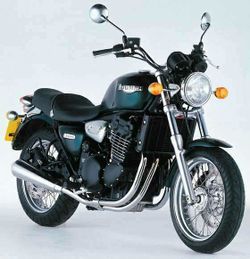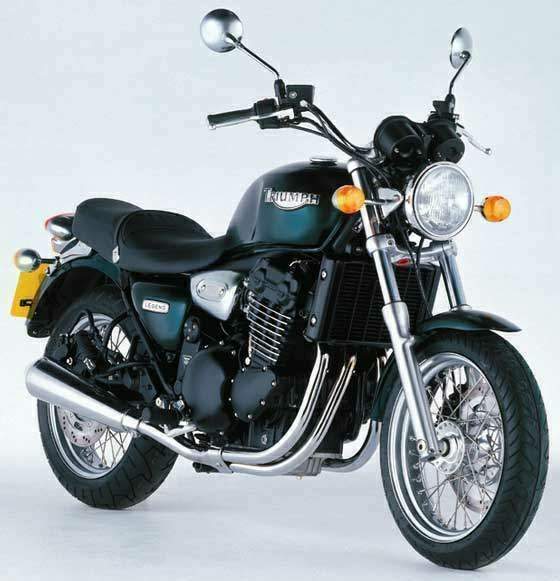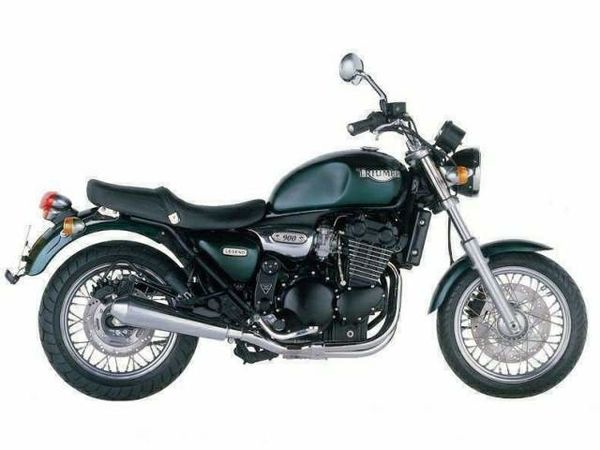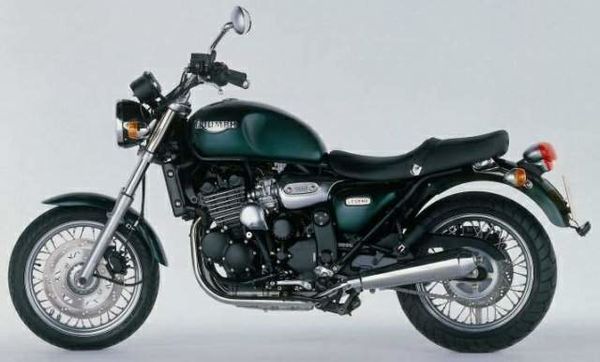Triumph Legend TT900
 |
|
| Triumph Legend TT900 | |
| Manufacturer | |
|---|---|
| Production | 1998 - 01 |
| Engine | Four stroke, transverse three cylinder, DOHC, 4 valves per cylinder |
| Compression ratio | 10.0:1 |
| Air Filter | K&N TB-9095 `99-01[1] |
| Ignition | Digital |
| Transmission | 5 Speed |
| Frame | Micro alloyed high tensile steel spine |
| Suspension | Front: 43 mm Forks with triple rate springs Rear: Monoshock with adjustable preload |
| Brakes | Front: Single 320mm disc, 2 piston caliper Rear: Single 285mm disc, 2 piston caliper |
| Front Tire | 120/70 R17 |
| Rear Tire | 160/60 R17 |
| Wheelbase | 1580 mm / 62.2 in |
| Seat Height | 725 mm / 28.5 in |
| Weight | 215 kg / 474 lbs (dry), |
| Fuel Capacity | 15 L / 4.0 US gal / 3.3 Imp gal |
| Manuals | Service Manual |
Engine[edit | edit source]
The engine was a Liquid cooled cooled Four stroke, transverse three cylinder, DOHC, 4 valves per cylinder. The engine featured a 10.0:1 compression ratio.
Drive[edit | edit source]
Power was moderated via the Wet, multi-plate.
Chassis[edit | edit source]
It came with a 120/70 R17 front tire and a 160/60 R17 rear tire. Stopping was achieved via Single 320mm disc, 2 piston caliper in the front and a Single 285mm disc, 2 piston caliper in the rear. The front suspension was a 43 mm Forks with triple rate springs while the rear was equipped with a Monoshock with adjustable preload. The Legend TT900 was fitted with a 15 L / 4.0 US gal / 3.3 Imp gal fuel tank. The bike weighed just 215 kg / 474 lbs. The wheelbase was 1580 mm / 62.2 in long.
Photos[edit | edit source]
Overview[edit | edit source]
Triumph Legend TT
Essentially a budget version of the Thunderbird, the Legend was introduced in 1998 in two versions. The basic Legend TT had 43cm (17in) wire-spoked wheels and an extra-low seat height. The Legend Deluxe had an even lower seat, and came with two-tone paintwork. Both bikes shared the 885cc liquid-cooled triple engine of the Thunderbird, its 51kW (69bhp) and torquey power delivery giving relatively sprightly performance. Cost cutting (the Legend was almost S2.000 [$3,200] cheaper than the Thunderbird) is hard to spot on the Legend, and it offers good value for an entry-level machine. Triumph's strong build quality and finish are continued on these models, and both engine and chassis are almost identical to the Thunderbird.
The Legend TT is designed for riders looking for a classically styled roadster with lively performance plus everyday versatility. Like Triumph's other classically styled bikes, the Legend features an appealing blend of period styling plus modern engine and chassis engineering, with a look that is clean and classically elegant. A teardrop fuel tank, reverse-cone silencers and traditional laced wheels with chromed rims combine with the distinctive three-cylinder engine to give an attractive period feel. The 885cc, liquid-cooled motor comes with a durable powder-coated finish, and follows the successful format set by Triumph's other classic triples. It is tuned for crisp throttle response and generous torque output at low and medium engine speeds. The Legend is notably easy to ride, thanks to its low seat and a chassis designed for easy handling. The engine is available with a restriction kit*, which makes it an ideal entry to the world of three-cylinder classic motorcycling. For owners who enjoy personalizing their machines, the Legend's distinctive look can be further enhanced with a selection from Triumph's extensive range of accessories.
Engine:
Proven 885cc liquid-cooled 3-cylinder engine with
DOHC, 12 valves.
Satin black powder coated engine for long term
durability, with classic styling.
Low maintenance hydraulic clutch operation.
Digital electronic ignition for precise combustion control.
Smooth shifting 5-speed transmission.
Raised overall gearing for relaxed cruising and improved economy.
Stainless steel exhaust headers with bright chrome
finish for durability and good looks.
Chrome reverse cone megaphone silencers for authentic
traditional style.
Chassis:
Lightweight, powder
coated steel spine frame, using engine as a structural member.
Anodized oval section aluminum alloy swing-arm.
Rising rate monoshock
rear suspension with preload adjustment.
43mm telescopic forks
with triple rate springs.
Traditional spoke wheels.
Stainless steel braided front brake line.
Low seat height for easy
maneuverability and rider confidence.
Classically-styled
instrumentation including: speedometer with odometer, trip meter, tachometer,
with warning lights for turn signals, main beam, oil pressure, low fuel,
engine temperature and neutral.
Hazard warning lights.
Color matched front and rear mudguards.
COLOR OPTIONS: Obsidian Black, Cardinal Red, Imperial Green
TRIUMPH ACCESSORIES
Integrated alarm
Summer Screen
Roadster Screen
Tank Bag
Leather
Pannier Kit
Soft
Panniers
Performance Silencer
King &
Queen Seat
Color
Coordinated Flyscreen
Grab rail
Sissy Bar & Luggage Rack
Chrome
Master Cylinder Guard
Chrome
Clutch Cover
Chrome
Radiator Guard
Outrigger
Finishers
Chrome
Chainguard
Chrome
Instrument Kit
Knee Pads
Front Mudguard Extension Kit
Fork
Protector Kit
Center
Stand Kit
Low
Handlebar Kit
Chrome
Water Pipe
Chrome
Lever Kit
Adjustable Levers
Side
stand
Kawasaki W650 and Triumph Legend TT -
There are two constants in motorcycling that we take for granted. One, the British motorcycle industry lived and died on charismatic twins and singles (and, OK, the occasional triple) that stuck to mature technologies to the bitter end. Brit bikes are either attractively iconoclastic or rotting and unreliable old sleds, depending on your point of view and tolerance for warm beer. Two, the Japanese motorcycle industry lives and dies on the incessant march of technology - even if it's sometimes liberated from other places-and would rather turn to making beaded moccasins than appear to be behind the times.
These are fine generalizations, facile and easy to digest, but they run increasingly against the grain. How's that again? Well, consider these two motorcycles as the levers that pry such preconceived notions right off the pavement.
Kawasaki is hot on retro bikes - modern motorcycles designed to look and, sometimes, feel like old ones. Its Eddie Lawson Replica replica, the ZRX1100, is selling like saddlestitch jeans to adolescent girls. And there's no misunderstanding the inspiration for the deep-fendered Drifter cruiser; it, too, is rolling out of showrooms at good speed. Retros are well into fever pitch in Japan, so Kawasaki figured to try them here and is cautiously dribbling some into the States in limited numbers.
Triumph has grasped its own history delicately between finger and thumb, selecting bits that are evocative but not precisely retrospective. Under John Bloor, the company has chosen to look ahead and make much more contemporary pieces. These converging paths lead to the Kawasaki W650 and the Triumph Legend TT: A Japanese bike that's convincingly British in character and performance, and a power cruiser from Hinckley that, for its polish and somewhat-anonymous styling, could well have Far Eastern roots. They share modest prices-$6499 for the W650 and $7699 for the Legend-and an acknowledgement that they won't be volume leaders. Think entry-retro.
Kawasaki W650 First things first. This is a Kawasaki, it says so right on the tank and seat, but it's trying hard, really hard, to be a 1960s Triumph Bonneville. Yes, Kawasaki can honestly say that the W650 traces its roots to the firm's own W1 and W1SA parallel-twins of the late 1960s and early '70s; but those bikes were pretty shameless knockoffs of Brit models of the time. And that's the point.
Kawasaki wants everyone from motorcycle know-nothings to seasoned riders who were there the first time to see the W650 and think Bonneville. The shape of the W650's tank, fenders, seat and engine all evoke-and in some cases closely replicate-the original's. From 20 feet, most nonenthusiasts would mistake the W650 for the real thing. And even those not easily fooled by Kawasaki's clever design (redesign?) staff, the overall impression is one of homage more than a calculated theft of someone else's history. (Could also be that Brit-bike fans are more sanguine about copies than harley nut jobs.)
One ride on the W650 will drag you back, perhaps writhing and groaning, into the netherworld of 1960s moto tech. The bars are wide and graceful, and the bike feels quite small and light for a 650-even though, at 453 pounds wet, it's not exactly in need of eating-disorder counseling. (Do you remember your daddy telling you that a 650 was a big bike?) The hard, strangely shaped saddle (replete with white piping) places you high above the bike, perched as though on a barstool. It's an odd impression for riders used to stumpy, dense sportbikes to teeter atop a thin, tall motorcycle. And it works fine in the city, but at speeds on the far side of 70 mph the W650 quickly becomes tiring to ride thanks to a losing proposition of upper-body strength against aerodynamics.
From this tippy columbarium, you stare down on instruments that, should you have no memory of the actual pieces, may remind you of wiggly needled Smiths clocks. (We eagerly await some hacker successfully programming faux waggle into the electronic gauges.) At the handgrips are switches you've probably not seen since Mach III days-all totally appropriate for the W650. (Can you imagine how awful modern switchgear would appear?)
Look behind your right leg and, yes, it's a kickstarter! We seldom used the electric assist and got the 676cc parallel-twin chuffing on the first or second prod every time. At idle, the massively undersquare (72.0 x 83.0mm) air-cooled twin thrums almost silently and barely raises its voice when being thrashed. Despite having four valves per cylinder actuated by a single overhead, bevel-driven cam, the W650's powerplant produces only modest power-44.8 hp at 6750 rpm. At least the 360-degree-crank engine-both pistons rise and fall together-carries its torque well, staying above 35 foot-pounds from 2000 to 6500 rpm. Thanks to 34mm CV carbs fitted with a throttle-position sensor and an accelerator pump, the engine is reasonably responsive, seeming only to work against a lot of flywheel effect.
Source Motorcycllist
| Make Model | Triumph Legend TT |
|---|---|
| Year | 1998 - 01 |
| Engine Type | Four stroke, transverse three cylinder, DOHC, 4 valves per cylinder |
| Displacement | 885 cc / 54 cu in |
| Bore X Stroke | 76 x 65 mm |
| Compression | 10.0:1 |
| Cooling System | Liquid cooled |
| Induction | 3 x 36 mm Flat slide CV carburetors |
| Ignition | Digital |
| Starting | Electric |
| Max Power | 50.3 kW / 69 hp @ 8000 rpm |
| Max Torque | 72 Nm / 7.3 kgf-m / 53.1 lb-ft @ 4800 rpm |
| Transmission | 5 Speed |
| Final Drive | Chain |
| Clutch | Wet, multi-plate |
| Frame | Micro alloyed high tensile steel spine |
| Front Suspension | 43 mm Forks with triple rate springs |
| Front Wheel Travel | 150 mm / 5.9 in |
| Rear Suspension | Monoshock with adjustable preload |
| Rear Wheel Travel | 136 mm / 5.4 in |
| Front Brakes | Single 320mm disc, 2 piston caliper |
| Rear Brakes | Single 285mm disc, 2 piston caliper |
| Front Tire | 120/70 R17 |
| Rear Tire | 160/60 R17 |
| Wheelbase | 1580 mm / 62.2 in |
| Seat Height | 725 mm / 28.5 in |
| Dry Weight | 215 kg / 474 lbs |
| Fuel Capacity | 15 L / 4.0 US gal / 3.3 Imp gal |
| Consumption Average (claimed) | 5.3 L/100 km / 18.7 km/l / 44 US mpg / 52.8 Imp mpg |
| Standing 1/4 Mile | 12.9 sec |
| Top Speed (claimed) | 201 km/h / 125 mph |
References[edit | edit source]
- ↑ 2019 K&L Supply Co Catalog. K&L Supply Co. 2019.


